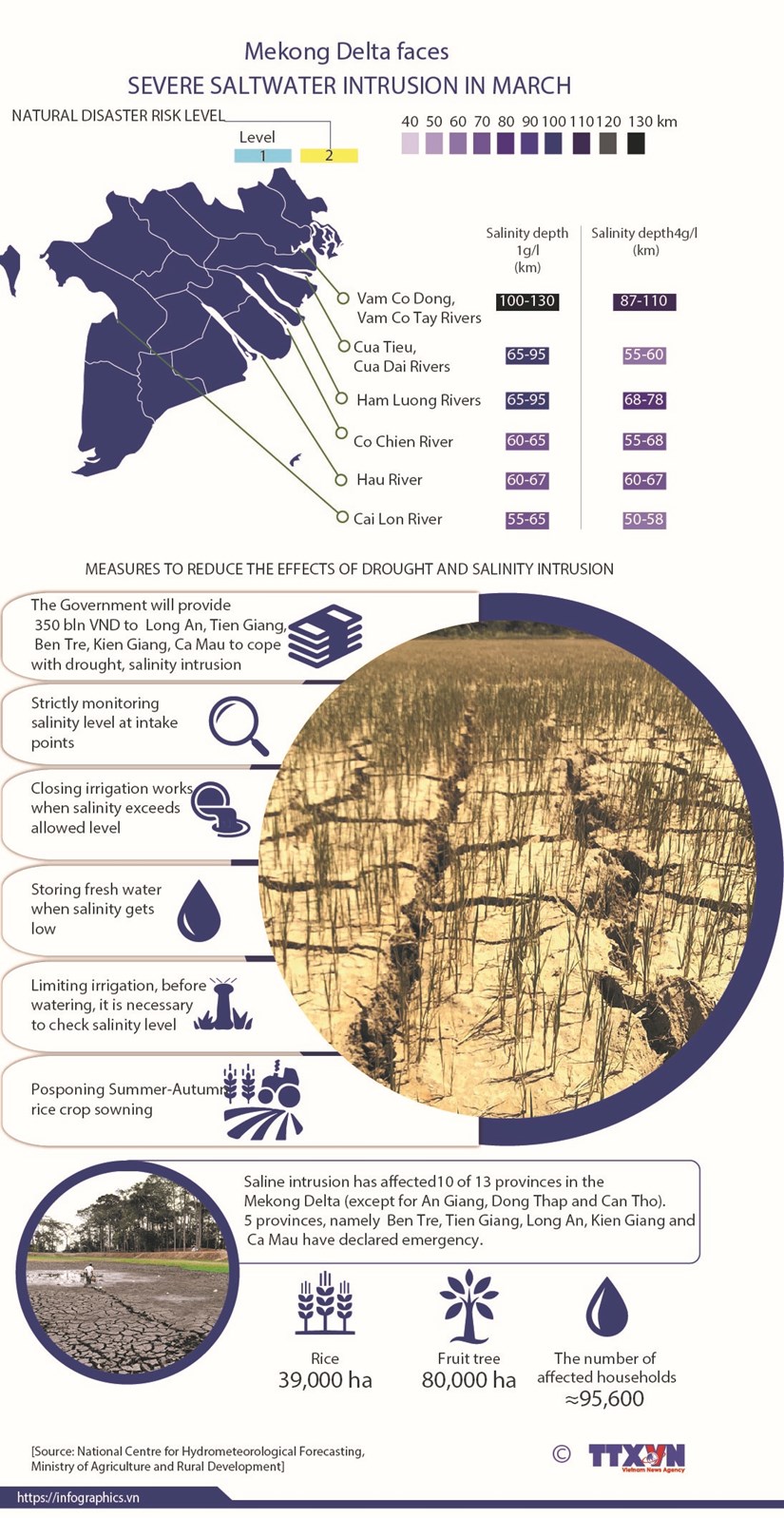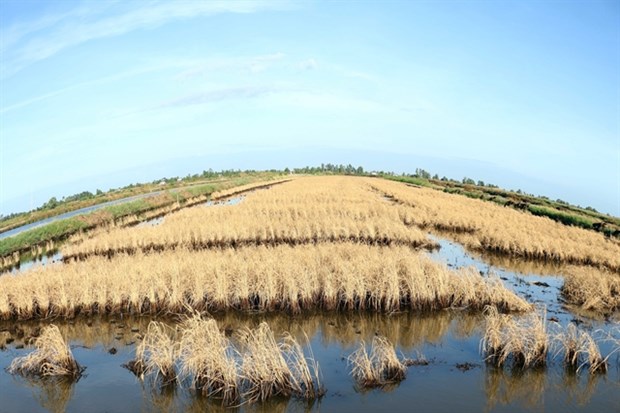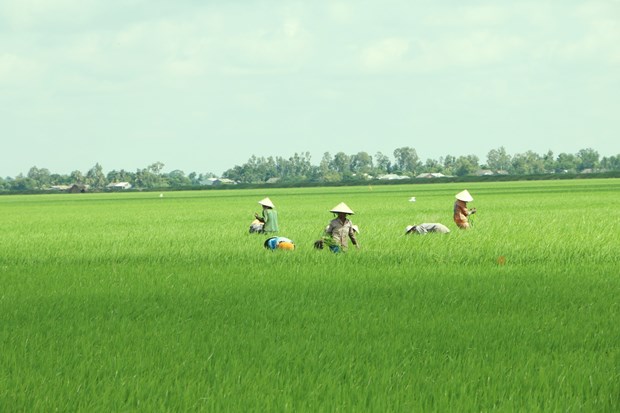- © Copyright of Vietnamnet Global.
- Tel: 024 3772 7988 Fax: (024) 37722734
- Email: [email protected]
saltwater intrusion
Update news saltwater intrusion
UNDP assists Mekong Delta in drought response efforts
 The UN Development Programme and the Partnership for Disaster Risk Reduction under the Ministry of Agriculture and Rural Development signed an agreement on March 17 to support the Mekong Delta’s response to drought and saltwater intrusion.
The UN Development Programme and the Partnership for Disaster Risk Reduction under the Ministry of Agriculture and Rural Development signed an agreement on March 17 to support the Mekong Delta’s response to drought and saltwater intrusion.
Mekong Delta faces severe saltwater intrusion in March
 The Mekong Delta region has been badly hit by saltwater intrusion. Experts have warned that the region will have to suffer prolonged drought and saline intrusion during the rest of this year’s dry season.
The Mekong Delta region has been badly hit by saltwater intrusion. Experts have warned that the region will have to suffer prolonged drought and saline intrusion during the rest of this year’s dry season.
Fresh water sent to areas hit by saltwater intrusion
 Fresh water supplies are being transported from HCM City to Mekong Delta provinces that have been affected by severe saltwater intrusion during the dry season.
Fresh water supplies are being transported from HCM City to Mekong Delta provinces that have been affected by severe saltwater intrusion during the dry season.
Mekong Delta provinces adapt to drought, saltwater intrusion
 Provinces in the Mekong Delta are taking prompt actions to help local residents adapt to drought and saltwater intrusion during the dry season.
Provinces in the Mekong Delta are taking prompt actions to help local residents adapt to drought and saltwater intrusion during the dry season.
Salinity forecast to worsen in Mekong Delta this month
 Saltwater intrusion will worsen in the Mekong Delta region in March, especially from March 11 to 15, when it will be more severe than the peak recorded in mid-February and in the same period in 2016.
Saltwater intrusion will worsen in the Mekong Delta region in March, especially from March 11 to 15, when it will be more severe than the peak recorded in mid-February and in the same period in 2016.
Mekong Delta takes measures to reduce saltwater intrusion
 Though saltwater intrusion in the Mekong Delta was predicted to come earlier and with higher level of salinity than that recorded in the 2015-2016 dry season, the damages to farming areas are expected to be less serious.
Though saltwater intrusion in the Mekong Delta was predicted to come earlier and with higher level of salinity than that recorded in the 2015-2016 dry season, the damages to farming areas are expected to be less serious.
Localities asked to stay active in coping with water scarcity
 The Ministry of Natural Resources and Environment (MoNRE) asked localities nationwide to stay active in responding to drought and saltwater intrusion, during a meeting in Hanoi on February 7.
The Ministry of Natural Resources and Environment (MoNRE) asked localities nationwide to stay active in responding to drought and saltwater intrusion, during a meeting in Hanoi on February 7.
Landslides in Mekong Delta attributed to sand exploitation
 The World Wildlife Fund (WWF) and Mekong River Commission (MRC) say the river bed of Mekong’s two main tributaries in Mekong Delta fell by 1.4 meters in 1998-2008 due to sand overexploitation.
The World Wildlife Fund (WWF) and Mekong River Commission (MRC) say the river bed of Mekong’s two main tributaries in Mekong Delta fell by 1.4 meters in 1998-2008 due to sand overexploitation.
Saltwater intrusion in Mekong Delta to ease by April
 Saltwater intrusion in the Mekong Delta might reduce between late March and June this year, according to Phung Tien Dung, head of the Hydrological Forecasting Department for the Central, Central Highlands and Southern region.
Saltwater intrusion in the Mekong Delta might reduce between late March and June this year, according to Phung Tien Dung, head of the Hydrological Forecasting Department for the Central, Central Highlands and Southern region.
Mekong Delta takes measures to cope with saltwater intrusion
 Saltwater intrusion has occurred on a large scale in the Mekong Delta, forcing local authorities to take measures to protect agricultural production and ensure water supply for household use.
Saltwater intrusion has occurred on a large scale in the Mekong Delta, forcing local authorities to take measures to protect agricultural production and ensure water supply for household use.
Saltwater intrusion enters Tra Vinh
 Saltwater intrusion has occurred in most areas of the Cuu Long (Mekong) Delta province of Tra Vinh, forcing authorities to close most saltwater-prevention sluices and to stop planting the 2019-20 winter-spring crop in some areas.
Saltwater intrusion has occurred in most areas of the Cuu Long (Mekong) Delta province of Tra Vinh, forcing authorities to close most saltwater-prevention sluices and to stop planting the 2019-20 winter-spring crop in some areas.
Saltwater intrusion to enter deeper in Mekong Delta
 Saltwater intrusion in the Mekong Delta during the dry season, is forecast to enter local rivers 30-40km deeper than the annual average.
Saltwater intrusion in the Mekong Delta during the dry season, is forecast to enter local rivers 30-40km deeper than the annual average.
Saltwater enters Mekong Delta rivers earlier than normal
 Many provinces have been bracing for it following a forecast that the intrusion of seawater up rivers would be early and severe this year.
Many provinces have been bracing for it following a forecast that the intrusion of seawater up rivers would be early and severe this year.
Mekong Delta may face more serious saline intrusion this dry season
 The Mekong Delta may experience sooner and even more serious droughts and saltwater intrusion in the 2019 – 2020 dry season, compared to the situation in 2016 when historic saline intrusion was recorded, an official has said.
The Mekong Delta may experience sooner and even more serious droughts and saltwater intrusion in the 2019 – 2020 dry season, compared to the situation in 2016 when historic saline intrusion was recorded, an official has said.
Mekong Delta’s sea level rise alarming: US professor
 Rising sea levels and saltwater intrusion in the Mekong Delta are becoming alarming, said Prof. David Dapice, Senior Economist, Vietnam and Myanmar Programme, Harvard Kennedy School, at a meeting with leaders of Can Tho city on October 8.
Rising sea levels and saltwater intrusion in the Mekong Delta are becoming alarming, said Prof. David Dapice, Senior Economist, Vietnam and Myanmar Programme, Harvard Kennedy School, at a meeting with leaders of Can Tho city on October 8.
Drought, saltwater intrusion loom in Vietnam's Mekong Delta
 The Mekong Delta plans to grow this year’s winter – spring rice crop early since drought and saltwater intrusion are forecast to be severe in the dry season starting at the end of this year.
The Mekong Delta plans to grow this year’s winter – spring rice crop early since drought and saltwater intrusion are forecast to be severe in the dry season starting at the end of this year.
Vietnam's Mekong Delta subsides up to 5cm each year
 The Mekong Delta region is sinking between 2 and 5cm per year, Lao Dong newspaper reported, citing source from the German Agency for International Cooperation (GIZ).
The Mekong Delta region is sinking between 2 and 5cm per year, Lao Dong newspaper reported, citing source from the German Agency for International Cooperation (GIZ).
Mekong Delta faces severe climate risks
 Nguyen Huu Thien, talks to the newspaper Thanh Niên (Young People) on the eco-system in the Mekong Delta and threats from climate change.
Nguyen Huu Thien, talks to the newspaper Thanh Niên (Young People) on the eco-system in the Mekong Delta and threats from climate change.
Mekong Delta sinking sparks concern
 Excessive groundwater exploitation is one of the main causes of land subsidence in the Mekong Delta region, the local media reported, citing sources at the Ministry of Natural Resources and Environment.
Excessive groundwater exploitation is one of the main causes of land subsidence in the Mekong Delta region, the local media reported, citing sources at the Ministry of Natural Resources and Environment.
Tien Giang coastal area manages to cope with drought, saltwater intrusion
The coastal area of Go Cong, a major agricultural hub in Tien Giang Province, has taken effective measures against drought and saltwater intrusion into rivers this year.



















